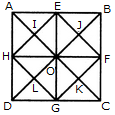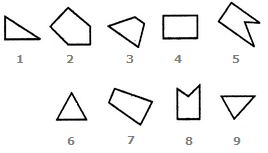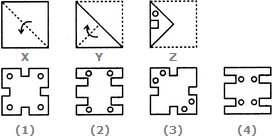Discussion
Home ‣ Non Verbal Reasoning ‣ Analytical Reasoning See What Others Are Saying!
- Question
Count the number of triangles and squares in the given figure.

Options- A. 44 triangles, 10 squares
- B. 14 triangles, 16 squares
- C. 27 triangles, 6 squares
- D. 36 triangles, 9 squares
- Correct Answer
- 44 triangles, 10 squares
ExplanationThe figure may be labelled as shown.
Triangles :
The simplest triangles are AEI, EOI, OHI, HAI, EBJ, BFJ, FOJ, OEJ, HOL, OGL, GDL, DHL, OFK, FCK, CGK and GOK i.e. 16 in number.
The triangles composed of two components each are HAE, AEO, EOH, OHA, OEB, EBF, BFO, FOE, DHO, HOG, OGD, GDH, GOF, OFC, FCG and CGO i.e. 16 in number.
The triangles composed of four components each are HEF, EFG, FGH, GHE, ABO, BGO, CDO and DAO i.e. 8 in number.
The triangles composed of eight components each are DAB, ABC, BCD and CDA i.e. 4 in number.
Total number of triangles in the figure = 16 + 16 + 8 + 4 = 44.
Squares :
The squares composed of two components are HIOL, IEJO, JFKO and KGLO i.e. 4 in number.
The squares composed of four components are AEOH, EBFO, OFGC and HOGD i.e.4 in number.
There is only one square EFGH which is composed of eight components.
There is only one square ABCD which is composed of sixteen components.
Total number of squares in the figure = 4 + 4 + 1 + 1 = 10.
More questions
- 1. Choose the correct mirror image of the given figure (X) from amongst the four alternatives.
 (X) (1) (2) (3) (4)
(X) (1) (2) (3) (4)
Options- A. 1
- B. 2
- C. 3
- D. 4 Discuss
Correct Answer: 4
- 2. NA
Options- A. 1
- B. 2
- C. 3
- D. 4 Discuss
Correct Answer: 2
Explanation:
NA
- 3. GLOBE
Options- A. .
- B. .
- C. .
- D. . Discuss
Correct Answer: .
Explanation:
Answer A
- 4. Group the given figures into three classes using each figure only once.

Options- A. 7,8,9 ; 2,4,3 ; 1,5,6
- B. 1,3,2 ; 4,5,7 ; 6,8,9
- C. 1,6,8 ; 3,4,7 ; 2,5,9
- D. 1,6,9 ; 3,4,7 ; 2,5,8 Discuss
Correct Answer: 1,6,9 ; 3,4,7 ; 2,5,8
Explanation:
1, 6, 9, are all triangles.3, 4, 7 are all four-sided figures.
2, 5, 8 are all five-sided figures.
- 5. Find the question mark
? figure from answer figure:

Options- A. 1
- B. 2
- C. 3
- D. 4 Discuss
Correct Answer: 2
Explanation:
From first figure to second figure the diagonals are deleted and both the dots are arranged vertically.
- 6. Select a suitable figure from the Answer Figures that would replace the question mark (?).
Problem Figures: Answer Figures:
 (A) (B) (C) (D) (1) (2) (3) (4) (5)
(A) (B) (C) (D) (1) (2) (3) (4) (5)
Options- A. 1
- B. 2
- C. 3
- D. 4
- E. 5 Discuss
Correct Answer: 1
Explanation:
The symbols move in the sequence . Also, the arrow rotates 135
oACW; the trapezium gets vertically inverted and the pin-shaped symbol rotates 90
oCW.
. Also, the arrow rotates 135
oACW; the trapezium gets vertically inverted and the pin-shaped symbol rotates 90
oCW.
- 7. Select a suitable figure from the Answer Figures that would replace the question mark (?).
Problem Figures: Answer Figures:
 (A) (B) (C) (D) (1) (2) (3) (4) (5)
(A) (B) (C) (D) (1) (2) (3) (4) (5)
Options- A. 1
- B. 2
- C. 3
- D. 4
- E. 5 Discuss
Correct Answer: 2
Explanation:
The upper element rotates through 180 o and its head gets inverted. The lower element gets vertically inverted.- 8. Choose a figure which would most closely resemble the unfolded form of Figure (Z).

Options- A. 1
- B. 2
- C. 3
- D. 4 Discuss
Correct Answer: 3
- 9. Find the question mark ? figure from answer figure.
Options- A. 1
- B. 2
- C. 3
- D. 4 Discuss
Correct Answer: 4
Explanation:
The first figure is bigger in each unit.
- 10. NA
Options- A. 1
- B. 2
- C. 3
- D. 4 Discuss
Correct Answer: 4
Explanation:
NA
Comments
There are no comments.
- 1. Choose the correct mirror image of the given figure (X) from amongst the four alternatives.
Programming
Copyright ©CuriousTab. All rights reserved.
